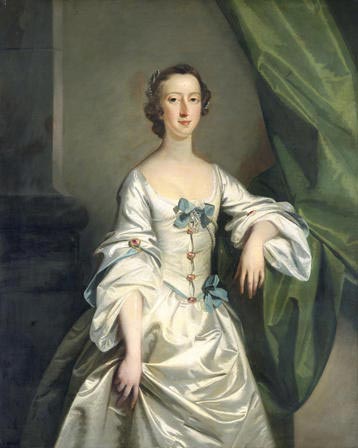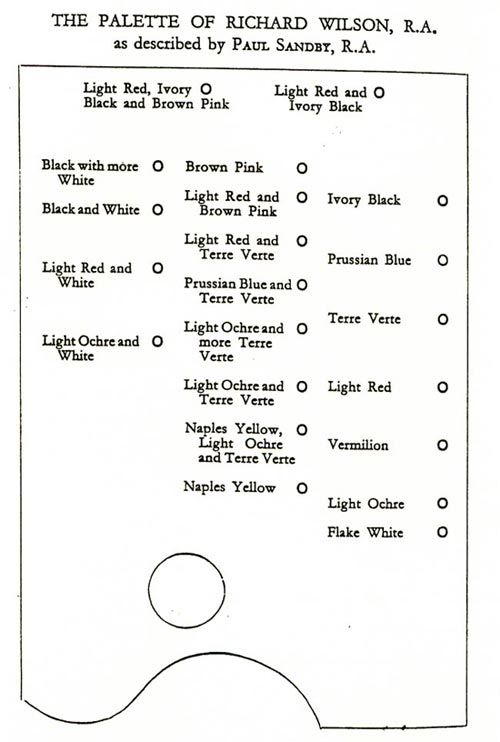An eighteenth-century painter at work: The techniques of Richard Wilson
Amgueddfa Cymru owns the largest collection of paintings by Richard Wilson outside London, holding over 20 paintings in its stores and on display to the public.
The Artist

Richard Wilson (1714-1782). This portrait was painted in Rome by Anton Mengs in return for one of Wilson's landscapes - a gesture of friendship and mutual admiration.

Portrait of a Lady: Maid of Honour. Richard Wilson (1714 - 1782)
On his return to London he hired several apprentices and paying pupils included Thomas Jones and Joseph Farington who both ended up adopting something of Wilson's studio practice.
Over the next fifteen years he produced large numbers of Italian, English and Welsh landscapes repeating the more popular subjects many times over. Gradually the market for this type of painting disappeared and his income dwindled. The Royal Academy, of which he had been a founder member in 1768, eventually appointed him as Librarian with a salary of £50 per annum. Eventually his health deteriorated and he retired to Colomendy near Mold where he died in 1782.
Portrait Painting Technique
Wilson's initial portraits date from 1740-50 and reflect the taste of his day. Subjects are usually shown bust-length in an oval with a suitable background echoing the aspirations of the sitter. Wilson's loose but masterly handling of paint is visible in the costumes of his subjects, showing details of fastenings and other decorative features. Wilson painted skin tones in three stages. The first colouring established the basics of the face using a shade tint for the darker tones and a light tint for the general flesh tone. The second painting, after the first was dry, consisted in heightening of the lights, glazing the darks and adding carmine to the lips and cheeks. The final or third painting allowed final corrections to the glazing.
A particular hallmark of his portraiture is the grey underpainting left exposed to form a mid-tone of the skin. This is easily visible in the portraits of
Richard Owen (NMW A 5005) and the Maid of Honour (NMW A 67).Landscape Painting Technique
Wilson decided to abandon portraiture in favour of landscape painting whilst in Italy. His landscape paintings were produced by first applying an underdrawing of brown paint, followed by ‘dead-colouring', a task which was given to the studio apprentices. Thin washes of colour were applied at this stage; Prussian blue and grey-brown for the sky, and a mixture of red and blue pigments for the landscape. The colour was applied to a thickness depending on the depth of tone required, allowing the light tone of the ground to show through more towards the horizon. Once the dead-colouring was dry it was oiled out before the second painting.
For the foreground Joseph Farington records that Wilson 'went over it a second time, heightening every part with colour and deepening the shadows, but still, brown, loose and flat, and left in a state for finishing: the half-tints laid in, without highlights.' In the third and final painting of the foreground Wilson altered the tints, adding the necessary sharpness to the different objects, before glazing them with rich warm tints, and finally adding further solid tints over this.
The sky and distant landscape, on the other hand, were worked wet-in wet after the initial dead-colouring, rather than in two separate stages. This allowed Wilson to achieve easier blending of the clouds with the blue of the sky, apparently using ultramarine rather than Prussian blue for this stage of painting. Last of all the horizon was adjusted and the distance softened with grey-brown again as necessary.
Drawing Practice
Drawing was important to Wilson with the first year of his pupils' training being devoted purely to drawing, which he believed gave them a good grounding 'in the principles of light and shade without being dazzled and misled by the flutter of colours.'
The majority of his surviving drawings date from his visit to Italy (1750-7). These are made up of studies taken directly from nature and designs drawn from his imagination. His preferred medium was black chalk and stump on a grey paper. He used these drawings as an inspiration for his oil paintings but rarely translated them directly into paint. He was constantly reworking the original designs and making adjustments as he painted.
In addition his colours were all derived from his visual memory or his imagination as he disapproved of tinted drawings and never used watercolours to make studies from nature.

Wilson's palette according to Paul Sandby from Whitley's Artists and their Friends in England 1700-1799. (Medici Society pub. 1928)
Wilson's Palette:
Both Joseph Farington, who became his pupil in 1763, and the watercolourist Paul Sandby, one of his friends, recorded Wilson's palette. Their accounts differ slightly but together give the range of pigments we would expect to find in his paintings.
Blues: ultramarine, Prussian blue, indigo
Reds: vermilion, light red, red lake
Yellows: yellow ochre, yellow lake, Naples yellow, brown pink
Browns: Roman ochre, burnt siena
Greens: terre verte
White: lead white
Black: ivory or bone black
At a glance:
- 1714: Born in Montgomeryshire
- 1728: Moved to London to take up apprenticeship with Thomas Wright
- 1735: Became Painter in his own right
- 1750: Travelled to Rome to developing his painting in the style of Poussin, Claude and Zuccarelli
- 1757: Returned to London training pupils such as Thomas Jones and Joseph Farington
- 1768: Founder member of The Royal Academy
- 1772: Appointed Librarian of The Royal Academy
- >1782: Died in Mold, Wales
Comments - (3)
wife or children.
I have just bought 3 small oil paintings under glass they are landscapes I believe of Italy, they are signed in black on right hand corner Wilson - they look very much in the style of Richard Wilson and the frames also look old . Could you tell me if Wilson ever signed his surname in full or did he always use his monogram?
Many thanks for any information you are able to give me.
Best regards
Lisa Migani